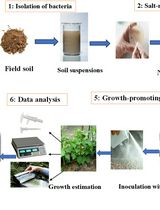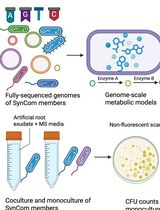- EN - English
- CN - 中文
Infection of Soybean Plants with the Insect Bacterial Symbiont Burkholderia gladioli and Evaluation of Plant Fitness
用昆虫细菌共生体唐菖蒲伯克霍尔德菌感染大豆植株及植物适应性评价
发布: 2017年12月20日第7卷第24期 DOI: 10.21769/BioProtoc.2663 浏览次数: 7779
评审: Andrea PuharDaniel F. CaddellAnonymous reviewer(s)
Abstract
To investigate the establishment and consequences of host-microbe interactions, it is important to develop controlled infection assays suitable for each system, as well as appropriate methods to evaluate successful infection and its associated effects. Here, we describe a procedure for bacterial inoculation of soybean plants, followed by the assessment of systemic infection and impact on plant fitness. Soybean (Glycine max) seedlings were mechanically wounded using a device that mimics insect herbivory and inoculated with known cell numbers of Burkholderia gladioli bacteria previously isolated from an insect host. The impact on the plants was evaluated by monitoring changes in height, time to flowering and chlorophyll content during plant development, and by quantifying seed production in comparison to plants inoculated with sterile water. The presence and proliferation of bacterial infection were examined in tissues from developed plants using quantitative PCR and fluorescence in situ hybridization (FISH).
Keywords: Bacterial plant infection (细菌植物感染)Background
Microbes establish symbiotic associations with diverse eukaryotic organisms and can have profound effects on host fitness, ranging from beneficial to detrimental (Frank, 1997). In many cases, these associations are directly or indirectly influenced by interactions with additional organisms, like potential alternative hosts. As an example, there are numerous three-way interactions between plants, microbes and insects, in which microbial symbionts are transmitted between the different hosts and affect the physiology or ecology of the organisms involved (Frago et al., 2012; Gilbert et al., 2012). In phytophagous Lagriinae beetles, a symbiotic partnership has been established with bacteria from a plant pathogenic clade, Burkholderia gladioli, suggesting that this association evolved in the context of a tripartite interaction. Horizontal transmission of the symbionts from Lagria villosa beetles to soybean plants was previously demonstrated, indicating the possibility for dynamic transitions between hosts (Flórez et al., 2017). Furthermore, the symbionts are transmitted vertically, from mother to offspring on the surface of the beetle eggs (Stammer, 1929), where they inhibit the growth of pathogenic fungi (Flórez et al., 2017). In line with the dynamic nature of this symbiosis, at least three different strains of symbiotic B. gladioli are present in L. villosa, of which only one has been successfully cultured in vitro so far (Flórez and Kaltenpoth, 2017). This protocol has been developed to assess the ability of culturable B. gladioli bacteria to infect soybean plants, a common food source for L. villosa beetles, and evaluate the impact of infection on plant fitness.
Materials and Reagents
- Materials
- Plant pots 6 cm diameter (Volume 120 ml)
- Plant saucers Ø 10 cm and 16 cm (lower and upper diameter, respectively)
- Centrifuge tubes 50 ml (Corning, Falcon®, catalog number: 352070 )
- Thin wood sticks 30 cm (Schreiber-Online-Handel, Splittstäbe Naturweide, catalog number: 231979935696 )
- Razor blade (Schreiber, 11-0100)
- Reaction tubes 1.5 ml (SARSTEDT, catalog number: 72.690.001 )
- Petri dishes Ø 9 mm (Carl Roth, GosselinTM, catalog number: ALA5.1 )
- 1 ml pipette tips (SARSTEDT, catalog number: 70.762.010 )
- Polysine® glass slides (Thermo Fisher Scientific, Menzel-Gläser, catalog number: J2800AMNZ )
- Microscope cover slips 24 x 60 mm #1 (Thermo Fisher Scientific, Menzel-Gläser, catalog number: CS2460100 )
- Aluminium foil
- Plant pots 6 cm diameter (Volume 120 ml)
- Plants
Soybean (Glycine max Merr., cv. 29-I, Semillas Panorama, Colombia) plants of V2 (2nd trifoliate) stage and of comparable height were used - Bacterial strain
Burkholderia gladioli Lv-StA bacterial culture stored in 30% glycerol at -80 °C, previously isolated from accessory glands of a female L. villosa beetle (Flórez et al., 2017) - Molecular biology working kits
- MasterPureTM Complete DNA and RNA Purification Kit (Epicentre, catalog number: MC85200 )
- QuantiTect® Reverse Transcription Kit (QIAGEN, catalog number: 205311 )
- SYBR® Green Rotor-Gene PCR Kit (QIAGEN, catalog number: 204074 )
- InnuPREP Gel Extraction Kit (Analytik Jena, catalog number: 845-KS-5030050 )
- MasterPureTM Complete DNA and RNA Purification Kit (Epicentre, catalog number: MC85200 )
- Other reagents
- Sterile tap water (autoclaved)
- H2O treated with DEPC (Diethylpyrocarbonate) (Carl Roth, catalog number: K028.1 )
- Liquid nitrogen
- RNaseZap® Decontamination Solution (Thermo Fisher Scientific, InvitrogenTM, catalog number: AM9782 )
- Ethanol 100% (Carl Roth, catalog number: 5054.5 )
- H2O2 6% in 100% ethanol (Carl Roth, catalog number: 9681.4 )
- DAPI (4',6-Diamidino-2-phenylindol Dihydrochlorid) (Carl Roth, catalog number: 6335.1 )
- Ethanol 70%
- Milli-Q® water
- VECTASHIELD® (Vector Laboratories, catalog number: H-1000 )
- Peptone from soybean (AppliChem, catalog number: A2206 )
- Potassium phosphate dibasic (K2HPO4) (Carl Roth, catalog number: P749.1 )
- Glycerol (Carl Roth, Rotipuran®, catalog number: 3783.1 )
- Agar-Agar Kobe I (Carl Roth, catalog number: 5210.2 )
- Magnesium sulfate hydrate (MgSO4·xH2O) (Carl Roth, catalog number: 0261.1 )
- Tris/HCl (Carl Roth, Pufferan®, catalog number: 4855.2 )
- EDTA solution pH 8.0 (EUROCLONE, catalog number: EMR034500 )
- Triton® X-100 (Carl Roth, catalog number: 3051.3 )
- Sodium chloride (NaCl) (Carl Roth, catalog number: 3957.1 )
- Potassium chloride (KCl) (Carl Roth, catalog number: 6781.3 )
- Sodium phosphate dibasic (Na2HPO4) (Carl Roth, catalog number: P030.1 )
- Potassium phosphate monobasic (KH2PO4) (Carl Roth, catalog number: 3904.2 )
- Chloroform (Carl Roth, catalog number: 7331.2 )
- Acetic acid 100% (Carl Roth, catalog number: 6755.1 )
- Sodium dodecyl sulfate (SDS) (Carl Roth, catalog number: 4360.1 )
- Sterile tap water (autoclaved)
- Media and buffers (see Recipes)
- King’s B liquid and solid medium
- Low TE-buffer
- PBS-Tx buffer
- Carnoy’s fixative
- Hybridization buffer
- Washing buffer
- King’s B liquid and solid medium
Equipment
- Sticky insect tape (CONRAD, GLUPAC, model: GB011 )
- Class II biological safety cabinet (Thermo Fisher Scientific, Thermo ScientificTM, model: Safe 2020 , 1.2)
- Glass inoculation spreader
- Scissors
- Forceps
- Drying oven (Memmert, model: INB 200 )
- Vortex (Scilogex, model: MX-S , catalog number: 821200049999)
- Micropipettes 1 ml and 10 µl (Eppendorf, model: Research® plus, catalog numbers: 3120000062 and 3120000020 )
- Chlorophyll meter (Konica Minolta, model: SPAD-502Plus )
- Spectrophotometer UV/VIS (Eppendorf, model: BioPhotometer 6131 , catalog number: 6131 000.012)
- Heater mixing block (Biozym, Bioer Technology, model: MB-102 )
- Micro-centrifuge (Eppendorf, model: 5418 , catalog number: 5418000017)
- Real-time PCR cycler (QIAGEN, model: Rotor-Gene Q )
- NanoDropTM 1000 spectrophotometer (Thermo Fisher Scientific, Thermo ScientificTM, model: NDTM-1000 )
- Fluorescent microscope (ZEISS, model: AxioImager Z1 )
- Colour camera (ZEISS, model: AxioCam MRm )
Software
- SPSS (version 17.0)
- RStudio (version 0.98.1103)
- AxioVision software (Lite Edition 4.8.1, ZEISS)
Procedure
文章信息
版权信息
© 2017 The Authors; exclusive licensee Bio-protocol LLC.
如何引用
Gaube, P., Kaltenpoth, M. and Flórez, L. V. (2017). Infection of Soybean Plants with the Insect Bacterial Symbiont Burkholderia gladioli and Evaluation of Plant Fitness. Bio-protocol 7(24): e2663. DOI: 10.21769/BioProtoc.2663.
分类
植物科学 > 植物免疫 > 宿主-细菌相互作用
微生物学 > 微生物-宿主相互作用 > 细菌
您对这篇实验方法有问题吗?
在此处发布您的问题,我们将邀请本文作者来回答。同时,我们会将您的问题发布到Bio-protocol Exchange,以便寻求社区成员的帮助。
Share
Bluesky
X
Copy link


.jpg)












